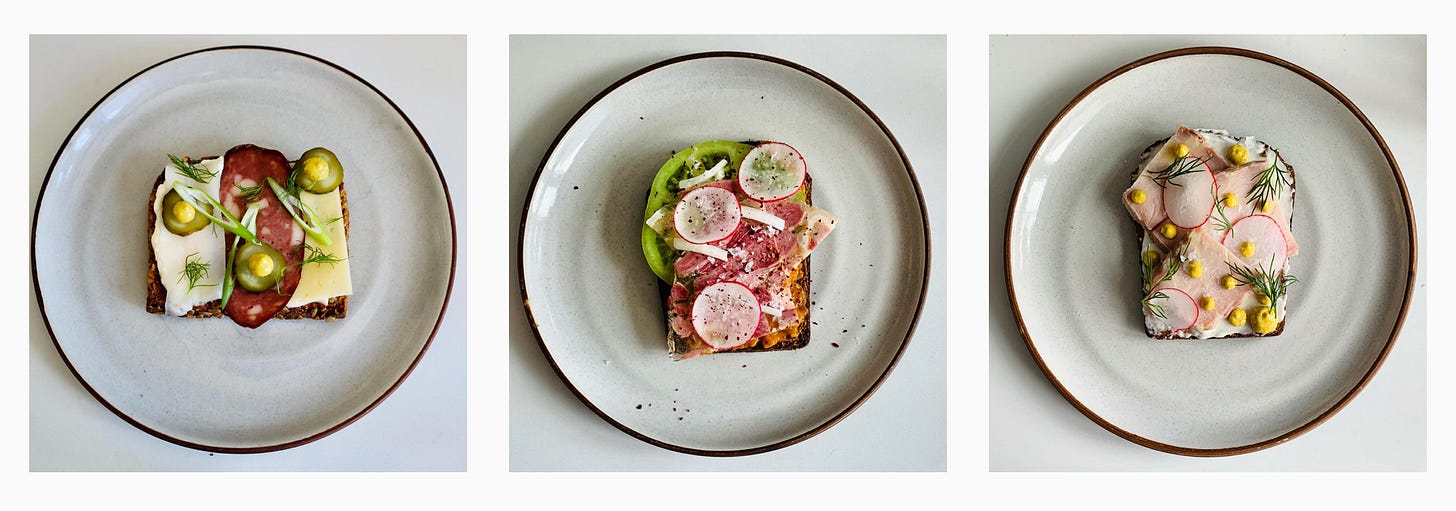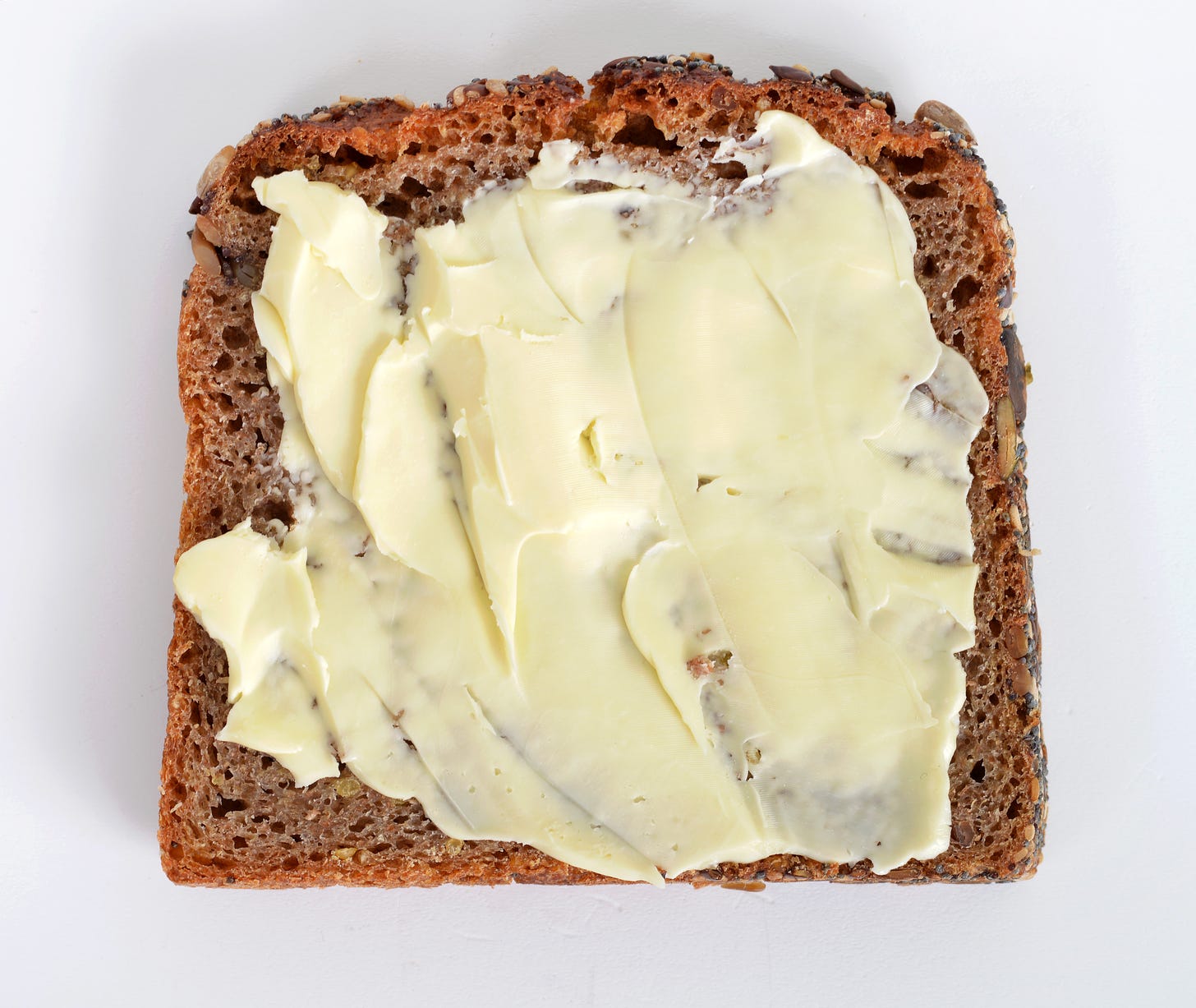Notable Sandwiches #24: Butterbrot
A foundational German staple does exactly what it says on the tin
Welcome to the latest installment of Notable Sandwiches, the feature where I, alongside my editor David Swanson, stumble through the demented and mysterious document that is Wikipedia’s List of Notable Sandwiches. This week, the German staple and widespread phenomenon of “butterbrot.”
Butterbrot, a longtime cornerstone of German cuisine, is one of those foods that advertises itself pretty precisely. This is not some deceptive “Baked Alaska” (ice cream and cake topped with flambéed meringue, not a gigantic landmass roasted in an oven) or delusory “Chicken à la King” (chicken in cream sauce over noodles, not a capon crowned, enthroned, and then slaughtered for its pretensions): a butterbrot is just what it says on the package—butter and bread. Generally, the bread is thinly sliced, with a generous layer of butter spread over it. This sturdy foundation can be embellished with further toppings—cheese, or wurst, or salmon, or jam, or Nutella, or schnitzel, or hard-boiled eggs, or whatever you wish, really, provided it’s roughly proportionate to the bread and isn’t yet another piece of bread, which would make it an English-style sandwich. Fundamentally, a butterbrod is a canvas primed with butter, an open-faced invitation to drape it in delicacies and sink your teeth in. The ubiquity of the butterbrot in Germany has receded somewhat in recent years, as trendier items like yogurt and muesli have usurped its place at the breakfast table. But it remains a staple. What differentiates it from an open-faced sandwich, you ask? Well, it has to start with butter. Which is, on the whole, not a bad place to start.
Naturally, the concept of butterbrot didn’t stay put in Germany. In fact, it shifted as soon as it hit the Austrian border: no longer the flexible base for any number of elaborations, an Austrian butterbrot is confined to just the bread and butter pairing (noted Austrian Wolfgang Amadeus Mozart wrote a whole “das butterbrot” piano piece about it, the swipe of the right-hand glissando mimicking the spreading of butter.) To the northwest, in Denmark, it took root as smørrebrød, a pillar of nordic eating to this day. It’s been conjectured that by the seventeenth-century reign of Germanophile tsar Peter the Great—who sought to Westernize Russia with the manic vigor of a true totalitarian—the butterbrot had drifted eastward as well, along with the German merchants, poets, generals, financiers and barons that peopled Peter’s Russia. The tsar’s obsession with all things European was matched, perhaps, only by his hubris: the city of St. Petersburg was his most enduring and famous project, and it was built on just-barely-subarctic swampland at the cost of thousands of laborers’ lives—largely conscripts, convicts, and prisoners of war who perished of disease and flood; one nickname for St. Petersburg is “the city built on bones.” By the 20th century, however, one could say (if one were being insufferable and writing a food column) that the people of Russia were a people built on butterbrot.

Butterbrot (or buterbrod, as бутерброд would be transliterated from Cyrillic) was not immediately the standard it’s become at every Russian table, however. (I ate countless varieties in Russia and Ukraine—in friends’ kitchens, in cafes, at train stations and just about anywhere else it makes sense to consume an ultra-portable slice of bread with stuff on it.) It took until the late nineteenth century for the dish to really catch on, largely because, until that point, butter as it was known in Germany didn’t exist for the vast majority of Russian people. The closest domestic equivalent was a sort of ghee-like clarified butter, made of cream baked in a cooling Russian oven (the traditional mammoth clay “pech” that dominated every peasant home and featured a shelf for the old and cold to sleep on.) It was fit to be stirred into porridge but not quite spread on bread on its own. (The product also melted back into liquid fat after a relatively short period of time; it’s possible that this is the reason that “butter” and “cooking oil” are both represented by the Russian word maslo).
Baked milk or cream remains the foundation of many Russian dairy products, including the quark cheese known as tvarog, sour cream (smetana), kefir, and the gently tangy drink known as ryazhanka; European-style butter was imported from Finland and restricted to the aristocracy, due to its great cost. It was only in the late nineteenth century that European-style butter began to catch on, with the secrets of its making imported from Paris by an enterprising aristocrat. By the turn of the twentieth century, the real thing began to be mass-produced in the famed Vologda butter plant.
By the Soviet era, butter—and with it the buterbrod that had migrated east with Russia’s now millions-strong population of ethnic Germans—was an everyday commodity. The Book of Healthy and Tasty Cooking, a Soviet cookery bible created by People's Commissar of the Food Industry of the USSR Anastas Mikoyan and initially published in 1939, contains no fewer than nine separate recipes for varying buterbrods (along with helpful tips like “fish for sandwiches should be free of bones”).
And so the butterbrot spread: to Ukraine, Azerbaijan, Kazakhstan, Armenia, Georgia, across the 11 Soviet timezones, immortalized in the pages of The Book of Healthy and Tasty Cooking across all dozen of its encyclopedic editions. “With its didactic commentaries, ideological sermonising, neo-Enlightenment scientific excursions, and lustrous photo spreads advertising the glories of Soviet canneries, fisheries and meat-processing plants,” writes Russian food memoirist Anya von Bremzen, “[The Book of Healthy and Tasty Cooking] offered a complete blueprint of ‘joyous’, ‘abundant’, ‘cultured’ socialist living... Kremlin winds shifted and commissars vanished, but the official myth of abundance persisted—and Soviet citizens clung to the fairytale.”
So the German dish became part of the vast Soviet experiment; and when that empire fell, it simply became another ubiquitous and ordinary part of Russian and Ukrainian (and Kazakh and Tajik and Turkmen) life, right alongside the products of Russian proto-butter that preceded it. Some things change and shatter with the rise and fall of regimes, the turning of the wheel of power. Some things—simple things, butter, bread, the human ingenuity that created them and combined them—carry on. And there’s something reassuring about that relentless continuity, inevitable as butter melting on the tongue.
P.S. In lieu of my usual plea for paid subscriptions, I’ll mention that for the past few days, I’ve been raising money for the Mississippi Reproductive Freedom Fund, largely by promising people on social media that I’ll chop up increasingly bizarre things with my various swords if they donate to fund abortion access. The fundraiser is here, and as a bonus, here’s a video of me going absolutely berserker on a tower of cake with a broadsword after raising $10,000:








you're face is perfect at the end